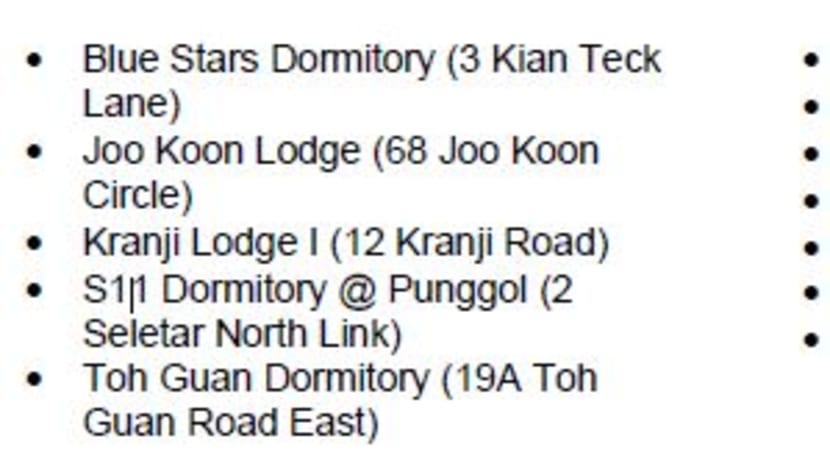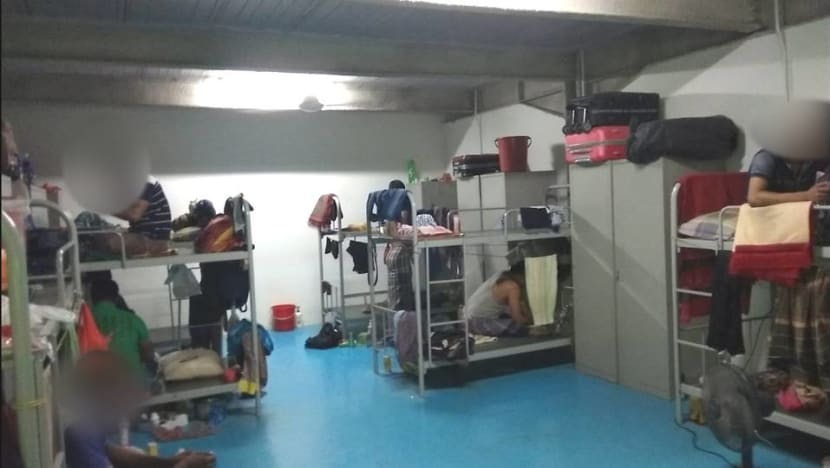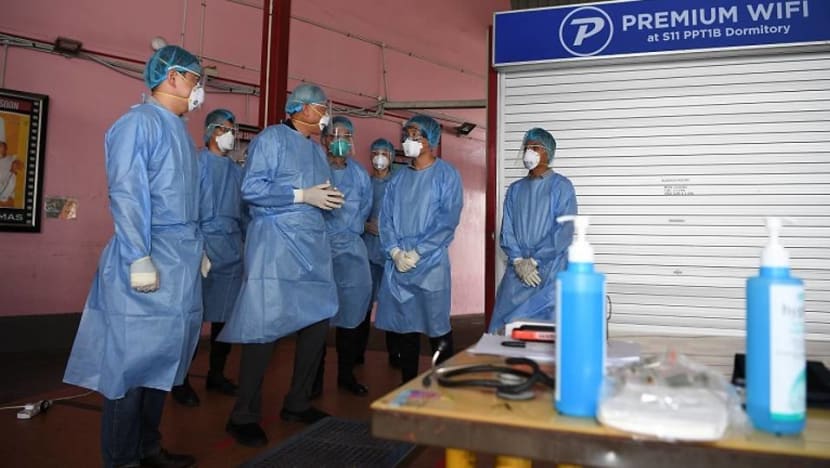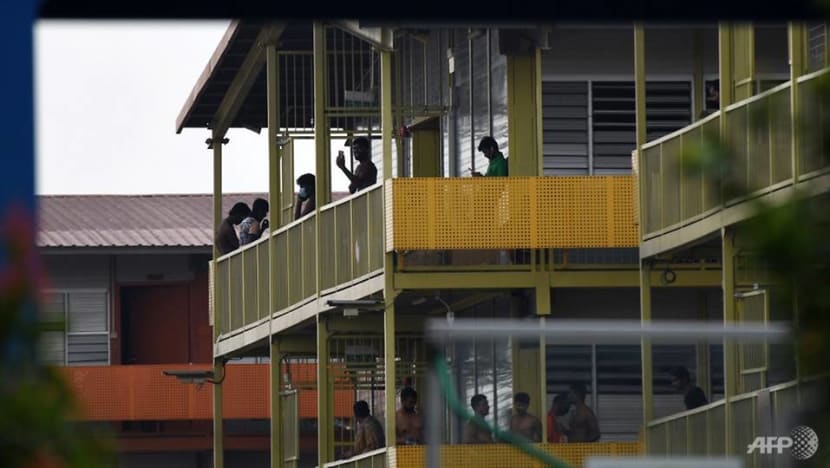A timeline: Singapore’s biggest COVID-19 cluster at S11 dormitory closes

Foreign workers at the S11 Dormitory @ Punggol in Singapore wave for a photograph, on Apr 6, 2020. (Photo: AFP/Roslan Rahman)
SINGAPORE: The COVID-19 cluster at the S11 dormitory @ Punggol – the biggest cluster in Singapore – has closed, the Ministry of Health (MOH) reported on Saturday (Aug 8).
The S11 dormitory recorded its first case more than four months ago and the last time a new case was linked to the cluster was on Saturday - with two additional cases linked. It took the total case count there to 2,846 – the largest COVID-19 cluster in Singapore.
Eleven other dormitory clusters were also closed on Saturday.
"The inter-agency task force has completed the clearing of dormitories through aggressive testing of workers," said MOH.
"The following dormitories have been cleared, and now house only recovered individuals and those who have recently tested negative for COVID-19 infection. As such, the clusters have now been closed."
The clusters that have now been closed on Saturday are:

It was at the S11 dormitory where one of Singapore’s first dormitory clusters was identified.
Cases at dormitories form the bulk of Singapore’s COVID-19 cases, with 51,993 infections as of noon on Saturday.
On Jul 18, MOH announced the closure of the second biggest COVID-19 cluster, at Sungei Tengah Lodge. On Jul 21, the Ministry of Manpower (MOM) said Sungei Tengah Lodge was clear of COVID-19.
READ: COVID-19: Dormitory with Singapore's second largest cluster among 69 more dormitories cleared
HOW THE S11 CLUSTER GREW TO SINGAPORE’S BIGGEST
The first two patients linked to the S11 dormitory - Cases 826 and 829 - tested positive for COVID-19 on Mar 28. The Bangladeshi and Indian nationals were admitted to Khoo Teck Puat Hospital, where they were treated.
Two days later, two more cases were linked, and MOH identified the dormitory as a new cluster.
The number of cases at the S11 dormitory would go up quickly, reaching 63 cases less than a week later on Apr 5.

The dormitory was gazetted as an isolation area, and together with Westlite Toh Guan, became the first two dormitories to have all workers quarantined in their rooms.
Manpower Minister Josephine Teo said then that the measures were put in place to ensure the health and well-being of “everyone”.
“Not just Singapore citizens, but also foreign workers who are here, helping our economy, and their employers. We want to give foreign workers the assurance that these measures are taken in their interests, and their well-being,” Mrs Teo added.
READ: COVID-19: Battling fear and boredom, migrant workers grapple with isolation in dormitories
Living conditions in dormitories became a talking point, as the cases continued to rise quickly. The Migrant Workers’ Centre, a non-government organisation linked to the National Trades Union Congress and the Singapore National Employers’ Federation, said the living conditions at the dormitory had “stabilised”, while MOM added that living conditions were improving.
On Apr 8, less than two weeks after the first cases were identified, there were 118 cases at the S11 dormitory. Other dormitories were also put into isolation as clusters grew.
A day later, the number of cases at the S11 dormitory more than doubled, to 283. About a week later, there were nearly 1,000 cases there.
It was also around then that MOH announced that medical teams comprising doctors and nurses from hospitals and polyclinics would be deployed to all dormitories, in a bid to curb the spread of COVID-19.

ANOTHER 1,000 CASES IN LESS THAN A WEEK
On Apr 17, there were 1,123 COVID-19 cases linked to the S11 dormitory. Less than a week later, on Apr 21, the number of cases climbed to 2,143.
On that day, migrant workers staying in dormitories were ordered to stop work and to stop moving in and out of dormitories until May 4. About 10,000 essential workers were transferred out of dormitories and housed separately.
Mrs Teo said this was something the Government “had planned for”, and that the workers were potential channels for infections in both directions when they moved in and out of dormitories.
READ: COVID-19: Movement in and out of dormitories to stop as all migrant workers to suspend work
On Apr 22, there was a sharp dip in the number of daily cases at the S11 dormitory, with 71 new cases linked to the cluster - compared to the 166 the day before.
By Apr 25, the number of daily new cases at the cluster had dropped to just six, the first single-digit increase in nearly three weeks. The tally on that day was 2,268.
The increase at the S11 cluster remained stable, with small spikes over the next week, bar a 134-case jump on Apr 29.

Health Minister Gan Kim Yong said on Apr 27 the rate of testing for migrant workers had not slowed and that MOH was increasing the capacity of testing of migrant workers.
By May, the cluster at the S11 dormitory had swelled with new cases every day for a month, but the rate of infection slowed dramatically to single-digit increases in late April.
Mrs Teo told Parliament on May 4 the situation within larger dormitories was mostly stable. The suspension of work and movement for all migrant workers in dormitories was extended to Jun 1, as clusters continued to grow in other dormitories.
Six days later, on May 10, MOH reported there were no new cases linked to the S11 dorm - the first time that had happened since the start of April.
READ: No new cases linked to Singapore's biggest COVID-19 cluster for first time since Apr 1
CONSECUTIVE DAYS OF NO NEW CASES AT S11
The cluster continued to see small increases in the number of cases all through May, with the exception of May 24, when 88 new cases were linked to the S11 dormitory.
With increasing testing capacity, isolation of migrant workers in dormitories, and stay-home notices for work permit and S pass holders in the construction sector, the number of new cases started to fall.
Before May was up, MOH reported three consecutive days - from May 27 to May 29 - when no new cases were linked to the S11 cluster.
Between Jun 7 and Jun 11, the cluster again experienced consecutive days without new cases, but on Jun 12, 15 more cases were linked to the cluster.

Less than two weeks later - from Jun 22 to Jun 27 - the health ministry recorded no new cases at the dormitory for six consecutive days.
Over July, the number of cases held steady, with small increases in the first week and second week - mostly in the single digits.
There were no new cases at the S11 dormitory between Jul 16 and Jul 26 - 11 days - its longest stretch with no new cases linked.
With new infections sporadically linked over the next week and a half, the latest two cases were added on Saturday, bringing the total number of confirmed cases linked to the cluster to 2,846.
The order declaring the dormitory an isolation area under the Infectious Diseases Act was revoked on Saturday.
BOOKMARK THIS: Our comprehensive coverage of the coronavirus outbreak and its developments
Download our app or subscribe to our Telegram channel for the latest updates on the coronavirus outbreak: https://cna.asia/telegram














